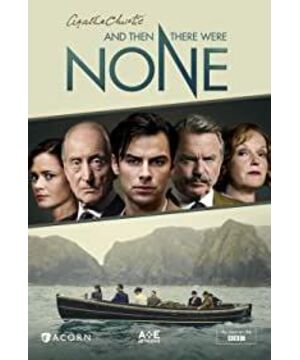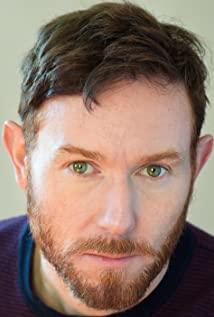Because it is the work of Agasha Christie, "No Life" has received different praise and enthusiasm. The TV adaptation is full of horror rewriting in front of the small screen, and the actor's performance is remarkable, and it is a good crime miniseries. However, And Then There Were None can become Agasha's classic work, not just because of the exquisite plot settings (not to mention the detailed modification in the TV adaptation, which dilutes the theme of the whole work, which will be mentioned in detail below), "sexual nature is evil" The excavation and extension of the theme is the most attractive part, which constitutes the beginning and development of the story. In the original novel, Agatha creates a character who is extremely bloodthirsty and loves murder but has an unusual sense of justice. It conveys between the lines: Those who act or fail to cause the death of others are the same as plain crimes and should be punished.#and In the TV series version, just use one sentence Ur all guilty to dismiss it # Agasha created this character is not the same as Dexter (Bloodthirsty Judge), this sense of justice is not cultivated, but accompanied by a sense of killing. It is different from Hannibal, because he has deep sympathy for the victimization of innocent people. The TV series changed the background of each victim, but weakened the murderer's motive. Comparison between TV series and original works, Mr. & Mrs Rogers used a pillow to suffocate his employer Mrs Brady to death/Mrs Brady became ill and did not take medicine in time. Instead, he deliberately wasted time looking for a doctor. General Mcarthur personally killed his wife’s lover and his powerful subordinates/assigned him to the battlefield ( Died), Lombard killed 21 primitive tribesmen for diamonds/ ran away alone at the moment of crisis and left them to die... The background settings in the book all describe an involuntary murder, although the criminals did not touch their hands. Full of the victim's blood, but it really pushed the victim to the end of life. The TV series version may allow viewers to enter the plot more quickly, making the motives of these people's murders obvious, but weakening the depth of the work. In the TV series, a passage between Judge Wargrave and Vera is used to unravel the mystery, which seems to have completed the climax of the whole series, but it always feels far-fetched. Not only is the motive of committing the crime unconvincing, but the process of committing the crime that interests everyone the most is also not well explained. How was the Murder Committed? In fact, there is a large section of seemingly unnecessary retelling of the case in the book, which greatly helps readers further understand who the murderer is. In the end, the murderer's own book confessed, and everyone really realized: 1. The police knew very well that Seton was more than guilty, even if he behaved pitifully. So among these 10 people, only one person is not a hidden criminal, and this person is the murderer who hunts down the criminal. 2. The second clue comes from the seventh of the poem, Four little soldier boys going out to sea A red herring swallowed on and then there were Three Red herring. In English proverbs, it means "sounding against each other." Armstrong's death is not literal. It is related to the sea (red herrring also means red fish), but it means that all his actions, including being killed, are used by someone or something, with the intention of misleading information. At the time, only the calmest people were able to induce Armstrong's confidence to assist in various behaviors. The TV series version described Armstrong as being highly nervous and easily mad. These characteristics all happen to Vera in the book. It would be more reasonable in common sense, and even the role of the slap that resounded throughout the book/drama was reversed. In the face of Rogers' death, Vera collapsed and laughed wildly in the book. It was Armstrong's slap that pulled Vera back, and in the play it was Vera who beat Armstrong. 3. The third clue is that the symbolic red mark on the head means Cain, and Cain, the eldest son of Adam and Eve, is a symbol of immortality. #Students who like vampires should also know that one of the legends is that Cain who is immortal is the ancestor of vampires using black magic# Agasha has its own unique reasons for the design and description of every detail. Here are a few books The details that appeared, but changed in the TV series: 1. The method of death of the victim, for example, in the book Emily Brent's method of death is by injection of poison through a pinhole. The bee outside the window for no reason is not only maddening, but also true It deepens the reader's further recognition of the murderer's obsession with "perfect murder". But the TV version was changed to be brutally inserted by the pen (or iron). 2. The order of death does not give a good explanation for the order of death. Unknowing audiences may think that it is just in the order of that American ballad, but in the book Agasha gives the murderer a very strong love and hatred. A clear sense of morality determines the order of death. He saves the victims who he considers the worst human nature to last, in order to allow her/him to bear the fear of the unknown future as much as possible. The annihilation of human nature does not appear in Agasha's book, because the murderer always believes that human nature is evil, but does not believe that innocent people are worthy of suffering. 3. The 10th victim killer does not count himself as the 10th victim. The book says that the 10th victim is Morris as an intermediary, which is not mentioned in the TV series. 4. The hidden position of the pistol This is also the place most easily criticized by everyone. In the TV series, the pistol and the master key are hidden in a wolf head decoration. Are you when the victim is blind...the pistol in the book is Hidden by the murderer in one of the countless canned foods. And the newly-added skeleton key stem also didn’t play any special role~~~~~ 5. The mystery revealed is different from the dialogue between the murderer and Vera in the TV series. The 10 victims in the book didn’t know who the murderer was until they died. . In fact, the original is already a very complete TV drama script, so some adaptations made by the BBC screenwriter really don’t feel much necessary. It is strongly recommended to look at the original. The last paragraph of the murderer’s text is really a finishing touch, which makes people There is no trace of fear for this murderer. He is a perfect criminal genius who is cute, principled, and persistent. Of course, the premise is that you have never done anything wrong. The mystery revealed is different from the dialogue between the murderer and Vera in the TV series. The 10 victims in the book did not know who the murderer was until they died. In fact, the original is already a very complete TV drama script, so some adaptations made by the BBC screenwriter really don’t feel much necessary. It is strongly recommended to look at the original. The last paragraph of the murderer’s text is really a finishing touch, which makes people There is no trace of fear for this murderer. He is a perfect criminal genius who is cute, principled, and persistent. Of course, the premise is that you have never done anything wrong. The mystery revealed is different from the dialogue between the murderer and Vera in the TV series. The 10 victims in the book did not know who the murderer was until they died. In fact, the original is already a very complete TV drama script, so some adaptations made by the BBC screenwriter really don’t feel much necessary. It is strongly recommended to look at the original. The last paragraph of the murderer’s text is really a finishing touch, which makes people There is no trace of fear for this murderer. He is a lovely, principled, and persevering perfect criminal genius~ Of course, the premise is that you have never done anything wrong.
Personal public number: DramaMatters
View more about And Then There Were None reviews











